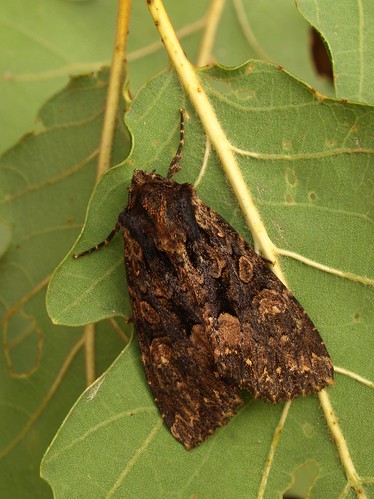 |
| Nagy Hőscincer Cerambyx cerdo Great Capricorn Beetle |
Whilst splitting logs yesterday I noticed that a couple of them had some decayed material on the surface and beetle galleries under the bark. Then I looked back at the pile of split pieces on the ground and was surprised to see a very large and beautiful longhorn beetle next to them. The insect was 53mm long and each antenna was 43mm long. Cerambyx cerdo, The Great Capricorn Beetle or Nagy hőscincér - a female, males have even longer antennae. The temperature was below zero but the sun was shining and the beetle slowly became active and began to move about. This insect is one of the largest European beetles and endangered throughout its range. It is listed on annexes II and IV of the EU Habitats Directive. A wood feeding species, its presence is an indication of 'healthy forest habitat' with long term continuity of deadwood - hence its increasing scarcity. The eggs are laid in or on deadwood parts of living trees and the later larval stages bore into sound wood where they eventually pupate. After eclosion the adult beetles overwinter in the pupation cavity. Like the Black Woodpecker, this species is regarded as an 'ecosystem engineer' because, through its excavation of living wood, it facilitates a whole assemblage of other forest species which either feed or breed within living and decaying wood.
 |
| 7cm tall cavity inadvertently opened by axe split |
 |
| part of the trunk with decaying sapwood containing various beetle galleries - perhaps where the insect first colonised the tree |
 |
| split surface showing tunnel leading to cavity in heart of trunk |
 |
| detail of cavity |
Working through the pieces of firewood I found the two sections of a log which when they came asunder had opened up a large cavity deep in the heartwood. Presumably this was a Great Capricorn Beetle pupal cavity. The firewood, from somewhere in the Bükk hills, was bought in August, but we do not know when it was felled, and it was split into quarter pieces shortly afterwards. The log was a sawn length of oak trunk with the bark on, 24cm long and probably about 25 to 30 cm diameter before it was split up. On one of the split faces there is a hole which presumably led to an exit or entrance at the exterior surface of the tree before it was split. This was oval in cross section and about 20mm x 11mm. The tunnel continues at a gradient of about 45 degrees (unclear if this was an incline or decline because I don't know which way up the log was originally) into the heart of the trunk and terminates in a 7cm long cavity. This is also roughly oval or flattened-cylindrical in cross section and c.30mm x 15mm. The mouth of the chamber is blocked with a dense pack of fibrous sawdust-like material and the walls of the cavity are clothed with partially detached fine wood fibres giving them a felted-like texture. The nearest exterior surface is 10 cm and the wood surrounding the cavity is completely sound and solid. In the sapwood there is a small column of decayed wood which also contains various beetle workings including the remains of a few small adult beetles which I think are Scolytids. However some of the sapwood borings are up to 7mm diameter and are perhaps the work of the earlier stages of Cerambyx larvae(?).
An amazing beetle, I feel sorry to have destroyed its incredible winter fastness and disturbed its hibernation. Other than with an axe or chainsaw it is difficult to imagine such a fortress being broken into. A determined predator like Black Woodpecker might be capable but it would hardly be worth the effort for a single beetle. No doubt the larval stages, when they are living closer to the bark, are taken in large numbers by woodpeckers though. A female beetle lays up to 300 eggs of which just 2 must reach adulthood (a process which takes 3 or more years) for a stable population to be maintained. I am now attempting to overwinter the insect in an artificial shelter in a cold cellar where it will be safe and am grateful to Francesco Vitali of the world Cerambycoidea forum for his advice.
References
Buse, J., Ranius, T. & Assmann, T. (2008) An endangered
longhorn beetle associated with old oaks and its possible role as an ecosystem
engineer. Conservation Biology 22, 329-37
EU Wildlife and Sustainable Farming project (2009) Great
Capricorn beetle – Cerambyx cerdo factsheet
(available at:
http://ec.europa.eu/environment/nature/natura2000/management/docs/Cerambyx%20cerdo%20factsheet%20-%20SWIFI.pdf)





































